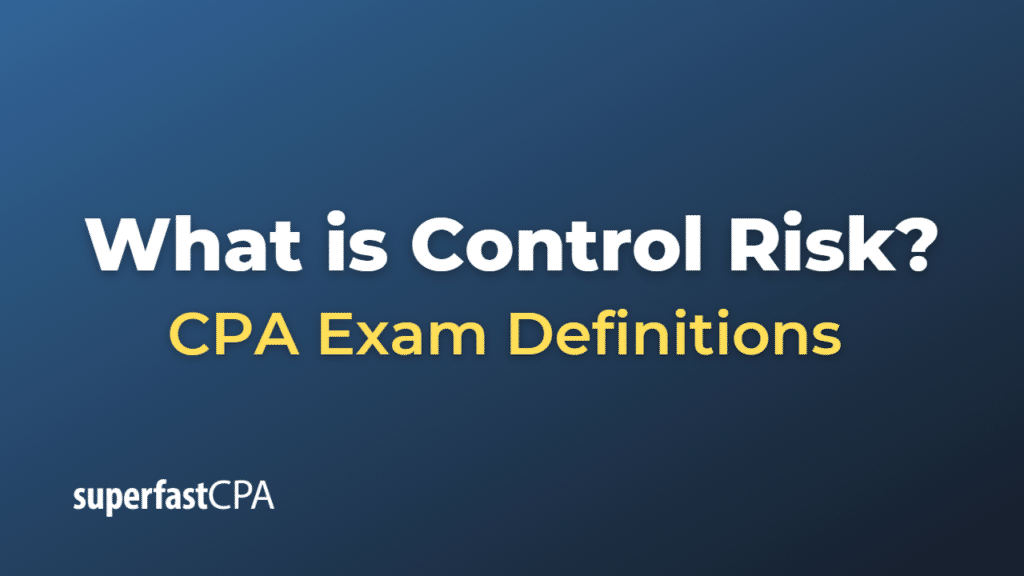Control Risk
Control risk is the risk that a material misstatement in an organization’s financial statements will not be prevented or detected and corrected on a timely basis by the organization’s internal control system. In other words, it is the risk that the internal controls in place are inadequate or ineffective in identifying and mitigating errors or irregularities in the financial reporting process.
Control risk is an essential component of the audit risk model used by auditors to assess the overall risk of material misstatements in financial statements. The audit risk model comprises three primary risks: inherent risk, control risk, and detection risk. The auditor’s objective is to minimize the overall audit risk, which can be achieved by evaluating and testing the effectiveness of an organization’s internal controls and adjusting the level of substantive testing accordingly.
Factors that can contribute to control risk include:
- Weaknesses in the internal control system: Inadequate design, implementation, or monitoring of internal controls can increase the likelihood of material misstatements going undetected.
- Human errors or fraud: Errors made by employees, management override of controls, or fraudulent activities can lead to material misstatements that the internal controls fail to identify or correct.
- Changes in the organization or its environment: Changes in the organization’s operations, personnel, systems, or external environment can cause previously effective controls to become inadequate or ineffective.
Auditors assess control risk as part of their audit planning process. They evaluate the design and effectiveness of an organization’s internal control system and determine the level of control risk. If control risk is assessed as high, the auditor may decide to perform more substantive testing to obtain sufficient evidence to conclude that the financial statements are free from material misstatements. On the other hand, if control risk is assessed as low, the auditor may rely more on the organization’s internal controls and perform less substantive testing.
Example of a Control Risk
Let’s consider a hypothetical example of a medium-sized manufacturing company and an external auditor who has been engaged to perform an audit of the company’s financial statements.
- Audit planning: During the audit planning phase, the auditor assesses the inherent risk, control risk, and detection risk related to the company’s financial reporting process. In this example, we’ll focus on the control risk assessment.
- Evaluating internal controls: The auditor reviews the company’s internal control system, including policies and procedures related to financial reporting, segregation of duties, authorization and approval processes, and IT controls. The auditor identifies several weaknesses in the internal control system, such as:
- Lack of proper segregation of duties, where the same employee is responsible for approving purchases and recording them in the accounting system.
- Inadequate review and reconciliation of financial statements by the company’s management.
- Weak IT controls, such as insufficient access controls and password policies for the company’s accounting software.
- Assessing control risk: Based on the identified weaknesses, the auditor assesses the control risk as high, indicating that the company’s internal control system may not effectively prevent or detect material misstatements in the financial statements.
- Adjusting audit procedures: In response to the high control risk assessment, the auditor decides to perform more substantive testing, such as detailed testing of transactions, account balances, and analytical procedures, to obtain sufficient audit evidence to conclude that the financial statements are free from material misstatements.
- Reporting and recommendations: After completing the audit, the auditor issues an audit report expressing an opinion on the company’s financial statements. Additionally, the auditor may provide recommendations to the company’s management on how to improve the internal control system and reduce control risk.
In this example, the auditor’s assessment of control risk plays a critical role in determining the nature, timing, and extent of audit procedures to be performed. By identifying and addressing control risk, the auditor can provide more reliable assurance on the accuracy and completeness of the company’s financial statements, while also helping the company improve its internal control system to prevent and detect potential errors or irregularities.













